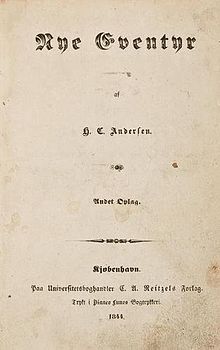New Fairy Tales (1844)

Cover of the first edition of Nye Eventyr.
|
|
| Author | Hans Christian Andersen |
|---|---|
| Original title | Nye Eventyr |
| Country | Denmark |
| Language | Danish |
| Genre | Literary fairy tale collection |
| Publisher | C. A. Reitzel |
|
Publication date
|
10 November 1843 |
| Media type | |
New Fairy Tales (Danish: Nye Eventyr) is a collection of four fairy tales written by Hans Christian Andersen and published by C. A. Reitzel in Copenhagen, Denmark on 10 November 1843. As was customary at the time however, the title page is dated 1844. The tales are completely Andersen's invention, owe no debt to folk or fairy lore, and are the most autobiographical of his several fairy tale collections. The collection was received enthusiastically by the Danish critics and public and became Andersen's break-through in the fairy tale genre. "The Nightingale" and "The Ugly Duckling" have been adapted to various forms of drama.
All the tales are Andersen's invention and the collection is the most autobiographical of his many works in the fairy tale genre. Andersen himself is the several heroes and heroines in the collection's tales – the awkward duckling, the nightingale, the gilded top.
"The Angel" tells of a dead child and an angel gathering flowers for Heaven. In a poverty-ridden section of the city, the angel retrieves a lily from a trash heap and explains the flower had cheered a dying child. The angel reveals he was that child. Andersen had been attracted to the sentimental 'dying child' theme since composing the poem, "The Dying Child", during his school days but the immediate catalyst was probably the death of the daughter of Edvard Collin, Andersen's close friend and lifelong homoerotic obsession. The tale suited the taste of the times and was wildly popular. The angel and child were depicted in a print that sold millions of copies.
In "The Nightingale", the Emperor of China enjoys the songs of both a real nightingale and a mechanical bird. When the mechanical bird breaks down and the Emperor is close to death, the real nightingale's song restores his health. The tale's Chinese setting was inspired by the then recently opened Tivoli Gardens in Copenhagen, and memorializes Andersen's unrequited love for singer Jenny Lind. The tale was completed in 24 hours on 12 October 1843. "The Nightingale" sets out in fairy tale form Andersen's artistic manifesto: naturalness and simplicity triumphing over artifice and reason. The tale is a variation on his earlier The Swineherd.
...
Wikipedia
